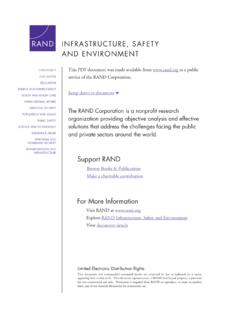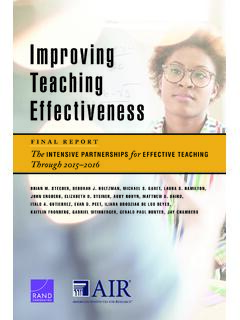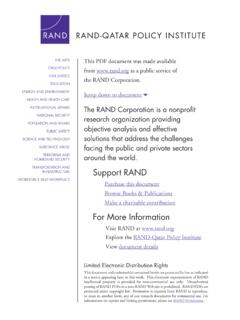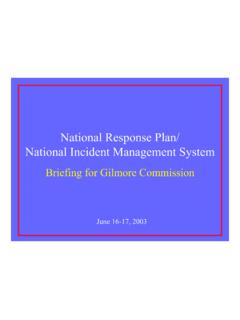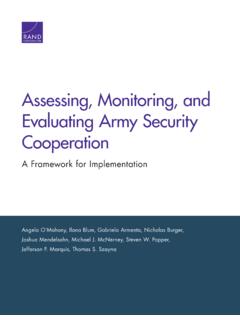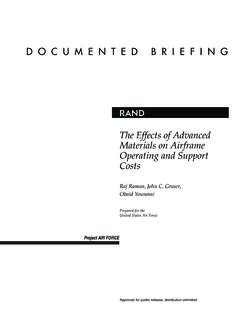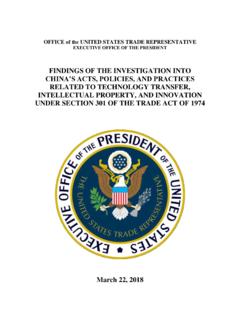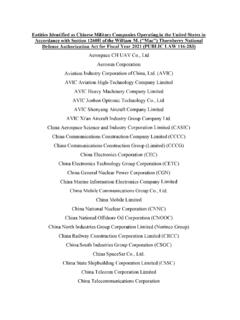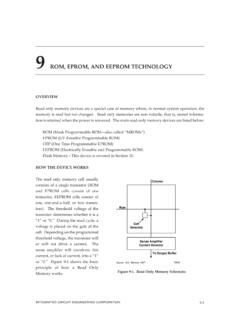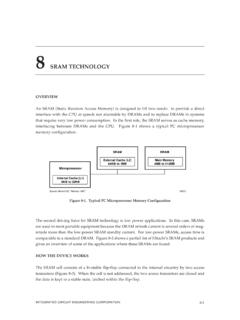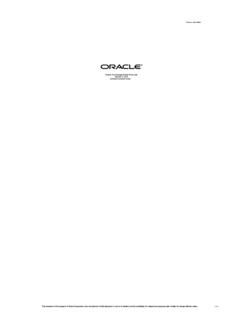Transcription of Autonomous Vehicle Technology - RAND Corporation
1 Autonomous Vehicle Technology A Guide for Policymakers James M. Anderson, Nidhi Kalra, Karlyn D. Stanley, Paul Sorensen, Constantine Samaras, Oluwatobi A. Oluwatola C O R P O R AT I O N. For more information on this publication, visit This revised edition incorporates minor editorial changes. Library of Congress Cataloging-in-Publication Data is available for this publication. ISBN: 978-0-8330-8398-2. Published by the rand Corporation , Santa Monica, Calif. Copyright 2016 rand Corporation R is a registered trademark. Cover image: Advertisement from 1957 for America's Independent Electric Light and Power Companies (art by H. Miller). Text with original: ELECTRICITY MAY BE THE. DRIVER. One day your car may speed along an electric super-highway, its speed and steering automatically controlled by electronic devices embedded in the road. Highways will be made safe by electricity! No traffic jams no collisions no driver fatigue.
2 Limited Print and Electronic Distribution Rights This document and trademark(s) contained herein are protected by law. This representation of rand intellectual property is provided for noncommercial use only. Unauthorized posting of this publication online is prohibited. Permission is given to duplicate this document for personal use only, as long as it is unaltered and complete. Permission is required from rand to reproduce, or reuse in another form, any of its research documents for commercial use. For information on reprint and linking permissions, please visit The rand Corporation is a research organization that develops solutions to public policy challenges to help make communities throughout the world safer and more secure, healthier and more prosperous. rand is nonprofit, nonpartisan, and committed to the public interest. rand 's publications do not necessarily reflect the opinions of its research clients and sponsors.
3 Support rand . Make a tax-deductible charitable contribution at Preface This report builds on rand 's long tradition of research on advanced technologies. From our research on world-circling spaceships in 1946. to developing the conceptual foundations of the Internet in the early 1960s, rand has long provided policymakers with guidance about tomorrow's world. rand 's recent research on the policy effects of Autonomous vehicles includes Liability and Regulation of Autonomous Vehicle Technologies, by Nidhi Kalra, James M. Anderson, and Martin Wachs (2009), and The Experience with No-Fault Automobile Insurance: A Retrospective, by James M. Anderson, Paul Heaton, and Stephen J. Carroll (2010). Both publications are available on rand 's website. This report results from the rand Corporation 's Investment in People and Ideas program. Support for this program is provided, in part, by the generosity of rand 's donors and by the fees earned on client-funded research.
4 The rand Transportation, Space, and Technology Program The research reported here was conducted in the rand Transporta- tion, Space, and Technology Program, which addresses topics relating to transportation systems, space exploration, information and telecom- munication technologies, nano- and biotechnologies, and other aspects of science and Technology policy. Program research is supported by government agencies, foundations, and the private sector. iii iv Autonomous Vehicle Technology : A Guide for Policymakers This program is part of rand Justice, Infrastructure, and Envi- ronment, a division of the rand Corporation dedicated to improving policy and decisionmaking in a wide range of policy domains, includ- ing civil and criminal justice, infrastructure protection and homeland security, transportation and energy policy, and environmental and nat- ural resource policy. Questions or comments about this report should be sent to the project leader, James Anderson, For more information about the Transportation, Space, and Technology Pro- gram, see or contact the director at This version of the report, RR-443-2, replaces an earlier version that contained an incomplete account of General Motor's policy on its use of OnStar customer data in footnote 8 on page 69, none of which affected the findings of the report.
5 Contents Preface.. iii Figures and Tables.. xi Summary.. xiii Acknowledgments.. xxv Abbreviations.. xxvii CHAPTER ONE. Introduction.. 1. What Are Autonomous and Automated Vehicles? .. 2. Why Is Autonomous Vehicle Technology Important Now?.. 4. What Decisions Do Policymakers Face?.. 6. CHAPTER TWO. The Promise and Perils of Autonomous Vehicle Technology .. 9. A Summary of the Social Costs of Driving.. 9. Effects of Autonomous Vehicle Technology on Safety and Crashes.. 12. Effect of Autonomous Vehicle Technologies on Mobility for Those Unable to Drive.. 16. Congestion.. 17. Potential Effects on Traffic Congestion.. 17. Potential Effects on the Costs of Traffic Congestion.. 24. Land Use.. 25. Energy and Emissions Implications of Autonomous Vehicles.. 28. Fuel Economy.. 28. Autonomous Vehicles Might Enable Alternative Fuels.. 33. How Will Travel Demand Affect Energy and Emissions?.. 36. v vi Autonomous Vehicle Technology : A Guide for Policymakers Costs and Disadvantages.
6 38. Conclusion.. 40. CHAPTER THREE. Current State Law and Legislative Activity.. 41. Nevada's Certificate of Compliance.. 42. Comparison of State Legislation.. 43. Nevada (NRS and NAC ).. 44. Florida (Fla. Stat. Title XXIII, Ch. 319, S 145).. 45. California (Cal. Veh. Code, Division ).. 46. Washington, (L19-0278).. 47. Ongoing Legislation in Other States.. 48. Arizona (HB 2167).. 48. Colorado (SB 13-016).. 48. Hawaii (HB 1461).. 49. Massachusetts (HB 3369).. 49. Michigan (SB 0169).. 50. New Hampshire (HB 444).. 50. New Jersey (A2757).. 50. New York (S4912).. 50. Oklahoma (HB 3007).. 51. Oregon (HB 2428).. 51. South Carolina (HB 4015).. 51. Texas (HB 2932).. 52. Washington (HB 1649).. 52. Wisconsin (SB 80).. 52. Stakeholder Interviews.. 53. Conclusion.. 53. CHAPTER FOUR. Brief History and Current State of Autonomous Vehicles.. 55. A Brief History .. 55. Phase 1: Foundational .. 56. Phase 2: Grand Challenges.
7 56. Phase 3: Commercial Development .. 57. State of Autonomous Vehicle .. 58. Contents vii Making Sense of the .. 58. Integrity, Security, and .. 70. Policy Implications.. 72. Conclusion.. 74. CHAPTER FIVE. The Role of Telematics and Communications .. 75. A Review of the Communications Technologies Used by Autonomous Vehicles.. 77. Commercial Wireless .. 77. Dedicated Short-Range Communications.. 79.. 80. Wi-Fi.. 80. Stakeholder Viewpoints on Autonomous Vehicle Communications .. 81. Spectrum Issues for Autonomous Vehicles.. 84. Who Regulates It?.. 84. Will Spectrum Regulation Affect the Deployment of Autonomous Vehicles?.. 85. How Will the FCC Proceed to Make Decisions Concerning DSRC. Spectrum?.. 85. How Will the FCC Weigh Competing Claims Concerning Spectrum Use?.. 86. Spectrum Policy Issues.. 91. Other Autonomous Vehicle Technology Communications Policy .. 93. Distracted Driving Laws.
8 93. Developmental .. 93. Data Security.. 94. Data Ownership and Privacy.. 94. Conclusion.. 95. CHAPTER SIX. Standards and Regulations and Their Application to Autonomous Vehicle Technologies.. 97. Overview of Regulations for Automobiles.. 98. Case Study: Air-Bag .. 100. viii Autonomous Vehicle Technology : A Guide for Policymakers Current Standards and Regulations for Autonomous Vehicle Technologies.. 103. Future Implications for Standards and Regulations for Autonomous Vehicle Technologies.. 106. Standards and Regulations to Facilitate Human-Machine Interaction.. 106. Performance Standards and Regulations .. 107. Conclusion.. 108. CHAPTER SEVEN. Liability Implications of Autonomous Vehicle Technology .. 111. Tort Liability for Drivers and .. 112. Theories of Driver Liability.. 112. Autonomous Vehicle Technologies, Liability of Drivers, and .. 114. Liability of Manufacturers.. 118. The Role of Cost-Benefit Analysis.
9 119. Types of Defectiveness.. 123. Human-Computer Interaction.. 126. Effect of Regulation on Liability and Preemption.. 128. Explicit Legislative Preemption .. 131. Conclusion.. 132. CHAPTER EIGHT. Guidance for Policymakers and Conclusion.. 135. Risks from Market Failure.. 136. Risks from .. 138. Risks from Liability.. 140. Federal Statute Limiting Tort.. 142. No-Fault Approach .. 143. Irrebuttable Presumption of Driver Control of Vehicle .. 144. Incorporation of Appropriate Cost-Benefit Tests in Liability .. 145. What Principles Should Guide Policymakers?.. 145. Policy Research Needs.. 146. Conclusion.. 148. Contents ix APPENDIX. Conclusions from Qualitative Interviews with Stakeholders.. 151. Bibliography.. 165. Figures and Tables Figures An Estimate of the Per-Mile Externalities Associated with Driving an Automobile.. 12. Roadway Accidents and Injuries per Million Vehicle Miles .. 13.
10 Roadway Fatalities per Billion Vehicle Miles Traveled.. 14. Relationship Between Roadway Speed and Roadway Throughput.. 22. Average Fuel Economy of Cars and Light Trucks, 1975 2012.. 29. Range of Potential Fuel Economy Improvements for Conventional, Hybrid, and Autonomous .. 31. Average Weight of Cars and Light Trucks, 1975 2012.. 32. Annual Vehicle Miles Traveled in the United States.. 38. Uses for DSRC.. 79. Tables Estimates of External Costs of Driving (2010$).. 10. Summary of Autonomous Vehicle Technology on Traffic .. 23. Potential Positive and Negative Effects on Total VMT.. 37. xi Summary Autonomous Vehicle (AV) Technology offers the possibility of funda- mentally changing transportation. Equipping cars and light vehicles with this Technology will likely reduce crashes, energy consumption, and pollution and reduce the costs of congestion. This Technology is most easily conceptualized using a five-part continuum suggested by the National Highway Traffic Safety Admin- istration (NHTSA), with different benefits of the Technology realized at different levels of automation: Level 0: The human driver is in complete control of all functions of the car.
